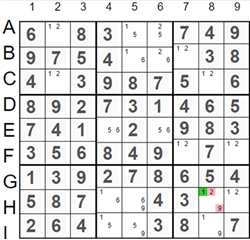
The image on the left presents another example of the Bivalue Universal Grave (BUG) technique. All cells in this puzzle have two candidates except for cell H8, which has three candidates. Additionally, each candidate appears twice in each row, column, and square, except for the number
'1' marked green, which appears three times in row H, column 8, and the last square. If we remove the number 1 from cell H8, it will appear twice in each row, column, and square, and the puzzle will not have a unique solution. To maintain a unique solution, we need to assign the number 1 to cell H8.